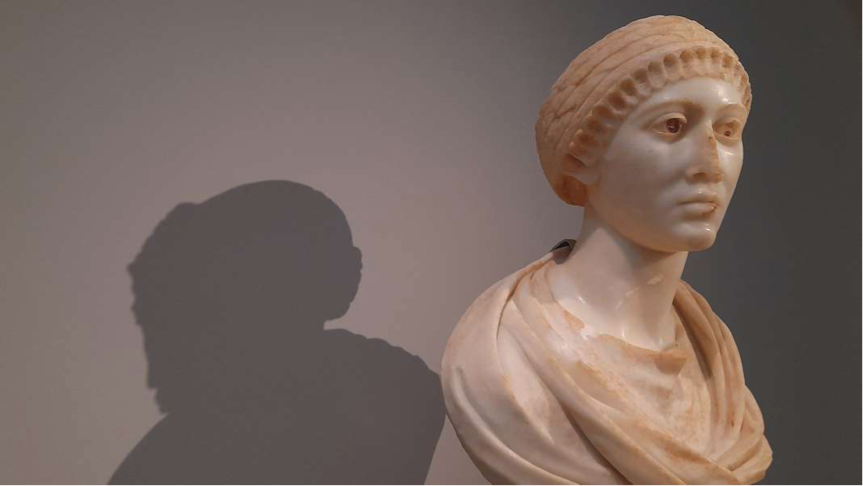Workshop
Metaphysics in Early Neoplatonism:
Form and Matter
in Porphyry and Iamblichus
Monday 6th November 2023
Rethymno, Institute for Mediterranean Studies
Nikos Svoronos Room (Kalos Ontas)
Alkis Ghinis (1933) Distinguished Insight of Inanimate Matter, 1976 Oil on canvas, 78 x 98 cm National Gallery, Inv. Number Π.5531
© 2015 National Gallery–Alexandros Soutsos Museum–Evripidis Koutlidis Foundation
Plotinus, the initiator of the movement known as Neoplatonism, bequeathed to his disciples two great problems along with his seminal insights. The first was, how can the multiplicity of Forms, which constitutes true being, emanate from the Unity that surpasses all being? The second is, how can matter, conceived as “metaphysical evil” (O’Meara 1991) and as complete absence of form, derive from the One? To resolve this paradox is to explain how evil can be generated by the Good, and how the immaterial can be present in the material. The workshop “Form and Matter in Porphyry and Iamblichus” investigates the solutions proposed by two of Plotinus’ earliest disciples, whose metaphysics and physics have been less studied in comparison to other aspects of their thought. This is due in part to the largely fragmentary nature of their surviving works on the higher realms of reality and on that which, according to them, lies beyond (divine) reality. The works that do survive are often dismissed as “soft” philosophy, so that their rigorous contributions to exegesis of Plato’s Parmenides and Timaeus are neglected, along with their thoughtful handling of the legacy of Aristotle’s hylomorphism.
We are interested in questions such as: How is the reception of Aristotelian hylomorphism by earlier commentators, including Alexander of Aphrodisias (Chiaradonna 2005; Rashed 2007), used within the framework of the agreement between Plato and Aristotle (Karamanolis 2004)? What is Porphyry’s and Iamblichus’ role in the transition from Plotinus’ understanding of matter as “metaphysical evil” to the later Neoplatonist doctrine of evil as παρυπόστασις (Steel 1998; Opsomer 2001)? How do their views on matter and immaterial presence relate to their understanding of sensible beauty or to their respective attitudes towards theurgy? How do they endeavour to solve the problem of the “gap” between the One and Intellect? Porphyry’s theory of incorporeals (Chiaradonna 2007; Viltanioti 2017) as well as his attempt to harmonise transcendence and coordination at the higher levels of reality (Smith 1987 = Id. 2011, XIV), which also evokes the Anonymous Commentary of the Parmenides (attributed to Porphyry by Hadot 1968; see also Chiaradonna 2014; Id. 2022; Smith contra Edwards 1990; Bechtle 1999, Corrigan 2000, Rasimus 2011) and its Christian reception (Tommasi 2021; Viltanioti 2021), are particularly relevant here. Does Porphyry posit triads at the higher levels of his ontological hierarchy, as Damascius and Lydus indicate with reference to his exegesis of the Chaldaean Oracles (366F-367F Smith)? Iamblichus, on the other hand, places the Completely Ineffable (παντελῶς ἄρρητον) One above the One (ἁπλῶς ἕν) followed by the One Existent (τὸ ἓν ὄν) through Limit and the Unlimited. Thus, he stresses the transcendent nature of the first principle, while also guaranteeing continuity between ontological levels. Within this framework, Proclus’ doctrine of the divine Henads, which bridge the gap between the One and the multiplicity of Being, seems to go back to Iamblichus’ reading of the Parmenides (Dillon 1993; Clark 2010; Mesyats 2012). What is the relationship between the Henads / the Gods and the Forms? How do the Gods, whom Plotinus situated at the level of Intellect, become the controversial supra-essential principles of the Forms?
Investigating these and other relevant questions, we intend to jointly examine some aspects of Porphyry’s and Iamblichus’ metaphysics and physics with a view to (a) identifying not only what divides Porphyry’s and Iamblichus’ approaches but also what unites them against both their common Plotinian background and later Neoplatonic developments, and (b) arguing for the strong connection between physics and metaphysics in late third-early fourth century Neoplatonism.

© Εphorate of Antiquities of Chania, Hellenic Ministry of Culture, Photo: I.-F. Viltanioti (2023)
Speakers and Titles:
Yury Arzhanov
(Paris Lodron University of Salzburg)
Porphyry’s Notion of Matter in the Light of Recent Discoveries:
The Treatise On Principles and Matter Preserved in Syriac
Michael Griffin
(University of British Columbia)
Attention and Inspiration:
Porphyry and Iamblichus on Living in Intelligible and Material Worlds
Irmgard Männlein-Robert
(Eberhard Karls Universität Tübingen)
Zeus as Nous: From Matter to Form via Symbols
(Porph. Περί ἀγαλμάτων 354F Smith)
Anne Sheppard
(Royal Holloway, University of London)
The Iamblichean Soul and the Problem of Evil
